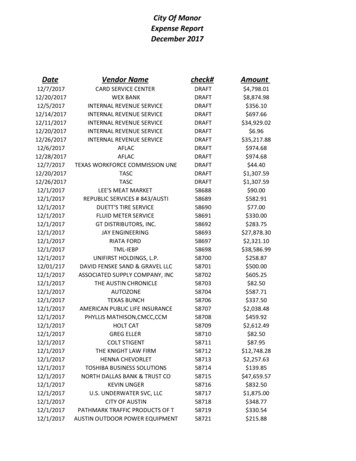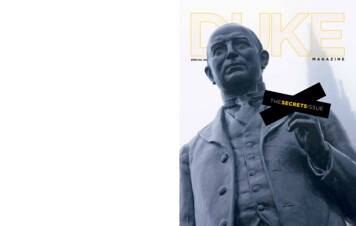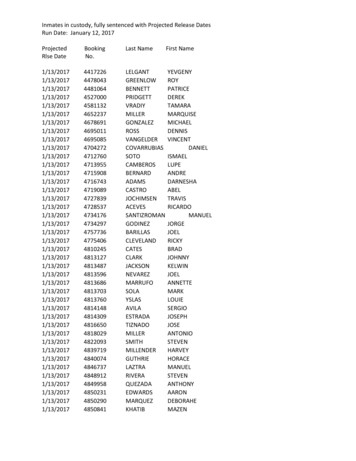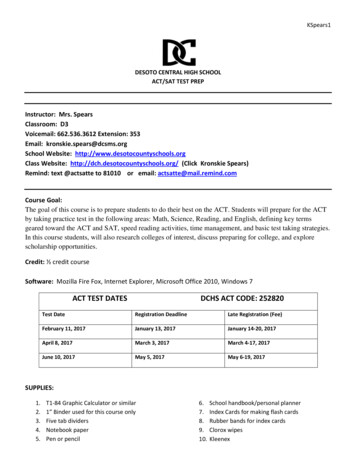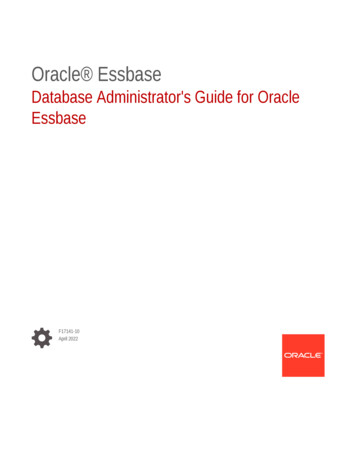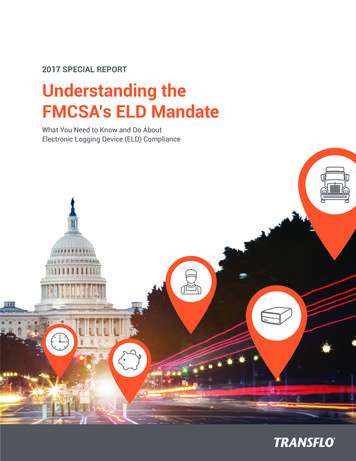
Transcription
2017 SPECIAL REPORTUnderstanding theFMCSA’s ELD MandateWhat You Need to Know and Do AboutElectronic Logging Device (ELD) Compliance
OverviewThe topic on everybody’s mind this year continues to beelectronic logging devices (ELDs). On December 10, 2015,the Federal Motor Carrier Safety Administration (FMCSA)issued a mandate requiring commercial trucking companiesto use an ELD to record their hours of service (HOS).The FMCSA stated that the new rule “improves commercial motor vehicle (CMV) safetyand reduces the overall paperwork burden for both motor carriers and drivers , [improving]compliance with the applicable HOS rules.”1Is the mandate here to stay? How does an ELD work? When is the compliance deadline? Tohelp carriers and drivers understand what they must know and do to comply with the newmandate, Transflo has prepared this special report entitled Understanding the FMCSA’sELD Mandate. The report addresses the following key topics:11ELD Foundations2FMCSA Requirements3Mandate Timeline4Facts and Figures5Benefits of Using ELDs6How to Introduce to Drivers7Transflo and ELD8Checklist for SuccessUnderstanding the FMCSA’s ELD Mandate
ELD FoundationsMoving from paper logs to electronic logs might seem like a big deal, but it’s really not. Electroniclogs actually look similar to their paper counterparts but come with many automated featuresthat make logging simpler. Logs appear on the screen of a smartphone or other wireless deviceand can generally be viewed, printed, or emailed to an inspection officer upon request.What is an ELDThe electronic logging device is a small device that can be held in the palm of your hand andplugged in to your vehicle. Once installed, the FMCSA notes that “an ELD synchronizes with avehicle engine to automatically record driving time, for easier, more accurate hours of service(HOS) recording2.” The introduction of ELDs was designed to reduce the burden of manual,paper-based work and replace it with automation that improves compliance.The ELD involves new technology, new processes, and new benefits. Today, those who need tocomply are using a combination of paper logs, automatic on-board recording devices (AOBRDs),ELDs, and other logging software. In the near future, all will be using ELDs.How does an ELD work?Instead of using paper logs, drivers can plug in an ELD then manage logs by using integratedsoftware on a mobile app. The app will even perform some of the functions automatically byreceiving truck data from the ELD. In addition to automating and simplifying paper-based logging,an ELD often has additional features that help fleets.ELDs can monitor engine health and activity, alerting drivers and fleet managers to maintenanceissues and usage patterns. ELD software provides information about engine status (on/off),engine hours, idling, vehicle movement, vehicle location, mileage, miles driven, and more. Toprovide many of these insights and to complement logging features, an ELD may include GPS,accelerometer, and cellular and/or Bluetooth capabilities.FeaturePurposeOBD-II ConnectionThe ELD connects to the engine through the OBD-II port to accessengine status, engine hours, idling, and more.AccelerometerAn accelerometer measures vehicle movements (side to side, upand down, and front to back).GPSA GPS determines vehicle location through satellite technology.Cellular or BluetoothA cellular or Bluetooth connection transfers data to a mobile device.Sample Dimensions: Width: 2” Height: 1” Length: 3”Bluetooth is a registered trademark of Bluetooth SIG, Inc.Understanding the FMCSA’s ELD Mandate2
FMCSA RequirementsAs with many regulations, the ELD mandate has taken years to research the loggingtechnology, analyze the regulatory impact, gather public feedback, publish the final rule, andprepare the industry. Some have since wondered whether the ELD mandate will move forward,be amended, or be withdrawn. There has been no indication, however, that the mandate willbe withdrawn or amended, and many trucking companies have already moved forward andpurchased an ELD so they can be compliant.In addition to compliance, many carriers have made the move to ELD because the price of analternative AOBRD is more expensive – often ranging between 500 and 2,000 whereas anELD’s price generally ranges between 100 and 200. Carriers are also realizing benefits by thesimultaneous convergence of fleet drivers moving from AOBRDs to ELDs and owner-operatorsmoving from paper to ELDs. For the first time, the fleet can now have all drivers using the sametype of technology.Mandate SummaryThe electronic logging device rule “requires ELD use by commercial drivers who are required toprepare hours-of-service (HOS) records of duty status (RODS).”3 In general, if you are alreadyrequired to maintain RODS, you will still need to do so under the mandate. You’ll just meet therequirement by using an ELD. The FMCSA estimates that 3.4 million commercial drivers aresubject to this new rule.4Commercial drivers who use paper RODS for 8 or more days, out of every 30-day period, willneed to use an ELD. Motor carriers who use paper logs today will need to use electronic logsunder the new mandate. And those currently using AOBRDs will also be required to use ELDs.The FMCSA notes certain exceptions to the mandate.Mandate Exceptions5:1.2.3.4.3Using paper duty status records for not more than 8 days out of every 30 days.Operating a vehicle that was manufactured prior to the year 2000.Driving a vehicle that is also the product to be delivered (drive-away/tow-away).Using time cards while conducting short-haul operations covered by an exemption.Understanding the FMCSA’s ELD Mandate
Mandate TimelineIf you are required to comply with the new ELD mandate, you must installand use ELDs by the following deadlines:DECEMBER182017Carriers and driversusing paper logs orlogging softwareare required use toelectronic logs.DECEMBER16Motor carriers stillusing AOBRDs arerequired to use ELDs.2019The timeline below summarizes the important dates and regulatory actions of the ELD Mandate.2012July 2012: The Commercial Motor Vehicle Safety Act, enacted as part ofMoving Ahead for Progress (MAP-21), mandates the ELD rule2014February 2014: The FMCSA releases Preliminary Regulatory Evaluation ofElectronic Logging Devices and Hours of Service Supporting DocumentsSupplemental Notice of Proposed Rulemaking2014April 2014: The FMCSA releases Evaluating the Potential Safety Benefitsof Electronic Hours-of-Service Recorders Final Report2015December 2015: The FMCSA releases its final rule with Electronic LoggingDevices and Hours of Service Supporting Documents2017December 18, 2017: Deadline by which drivers using paper logs mustbe compliant with new ELD rules2019December 16, 2019: Deadline by which drivers using AOBRDs must becompliant with new ELD rulesUnderstanding the FMCSA’s ELD Mandate4
Multi-phased ApproachThe FMCSA has organized the ruling into three phases of implementation and compliance.They are summarized in the table and descriptions below.Approved Log Methods by Phase6ELDAOBRDLogging SoftwarePaperPhase 1 Awareness and Transition2/16/2016 – 12/18/2017Phase 2 Phased-In Compliance12/18/2017 – 12/16/2019Phase 3 Full ComplianceBeyond 12/16/2019Phase 1: Awareness and TransitionDuring the awareness and transition phase, carriers and drivers subject to the rule shouldunderstand what they need to do and prepare to comply with the ELD mandate. They mayinstall and begin using ELDs.Phase 2: Phased-in ComplianceDuring the phased-in compliance phase, carriers and drivers subject to the rule may no longeruse logging software or paper as a means of compliance. They will now use approved ELDs tocomply. AOBRDs installed prior to Phase 2 may also be used to comply.Phase 3: Full ComplianceDuring the full compliance phase, all carriers and drivers who are subject to the federalmandate must be in compliance by using an ELD that meets the requirements of the rule.5Understanding the FMCSA’s ELD Mandate
Facts and FiguresThe ELD mandate aims to save time and money as well as improve safety and compliance.Listed below are some interesting stats behind the mandate. 705paperwork savingsBy reducing paperwork, companies can save 705or more per driver each year. Across your wholefleet, that’s powerful math! Here’s the breakdown:Annual Paperwork Savings per Driver7Elimination of Paper Log BooksDriver Submitting RODSClerk Filing RODSDriver Filing RODS 42 56 120 487Total Savings per Driver 70520hours per driverHow much time do drivers save by moving frompaper logs to electronic logs? Fewer and fasterinspections as well as less paperwork can save 20hours of driver time per year8. That’s 4.5 minutesof time saved per RODS!53%lower violation rate11.7%fewer crashesTrucks using ELDs have 11.7% fewer total crashesand 5.1% fewer preventable crashes10.3.4million driversThe FMCSA estimates that 3.4 million commercialdrivers are subject to this new rule4.1,500gallons of diesel1,500 gallons12 of diesel fuel are burned each yearby idling a heavy-duty truck. Insights from ELDreporting can help you reclaim fuel lost to idlingand operate more efficiently.Trucks equipped with electronic HOS recordershave a 53% lower driving-related HOS violationrate and a 49% lower non-driving-related HOSviolation rate than trucks without such devices9.Understanding the FMCSA’s ELD Mandate6
Benefits of Using ELDsThe following categories can be can be used to help fleets and drivers better understand howthe ELD mandate is beneficial.7Earn MoreRevenueUsing an ELD saves time, and that time savings equates to greater earningpotential. Fewer and faster inspections as well as less paperwork equal upto 20 hours of time saved each year8. Those are hours that can be convertedinto driving time to earn additional client revenue.Save SomeMoneyMost of the paper log burden falls on drivers. Buying log books, havingdrivers file and submit records, and performing clerical tasks all have costs.By using an ELD, you can save on many of these costs. In fact, the FMCSAestimated the total annual paperwork savings to be 705 per driver7!Avoid OtherExpensesElectronic logging automation improves accuracy of driver logs. Fewerviolations mean fewer fines. You’ll avoid some of the expenses associatedwith critical maintenance issues, vehicle downtime, unauthorized vehicleusage, and out-of-route miles.Achieve NewEfficiencyBy using an ELD, drivers and fleets can better plan the day. With the ELD’shours of service, alerts, and GPS features, you’ll know when and where totake breaks and stop for the day. Also, insights from speeding and engineidling reports can lead to changes that improve fuel efficiency.ImproveSafetyTrucks with ELDs have 11.7% fewer total crashes and 5.1% fewer preventablecrashes10. You’ll benefit from accelerometer and accident reconstructionfeatures that validate safe driving, a key factor in determining insurancerates. With real-time ELD mapping, roadside assistance is faster.StrengthenReputationE-Logs increase compliance and reduce violations, both of which improveCSA scores. They also document safety and compliance success, whichcould lead to better jobs and higher pay for drivers. Companies may also bemore willing to do business with you when they know you’re ELD compliant.EnhanceQuality of LifeELDs reduce tedious activities like DVIRs and IFTA reporting, including phonecalls just to check in. They may also reduce IFTA audit risks. ELDs lead tomore meaningful coaching, decreased driving while fatigued, and accuratepay information–enhancing quality of life and reducing driver turnover.Understanding the FMCSA’s ELD Mandate
How to Introduce to DriversMost people aren’t thrilled about the idea of new regulations changing the way they dobusiness. For the most part, commercial drivers feel the same way. Many view the mandateas infringing on personal privacy. That being said, many also recognize that using an ELDmay make the job easier. Routine tasks are automated, and work is completed quickly andaccurately. The likelihood of audit may go down. And paperwork completion is less tedious. Allof these factors positively affect drivers.Many drivers also recognize that their fleets achieve benefits from ELD usage. Asset utilization,safety, navigation, fuel efficiency, record-keeping, and compliance may all be improved. Thatcreates a more efficient fleet, and a more efficient fleet is a more profitable fleet. That’s ashared benefit with drivers.You may find the following tips helpful as you introduce an ELD program to drivers:1Explain 2Train 3Describe the mandate, openly discuss the pros and consInvolve drivers and key employees earlyCommunicate ELD plans, programs, timelines, and goals well in advancePost announcements, ELD educational material, FAQs etc.Listen to feedback and suggestions, address feelings and concernsRollout in “waves,” starting with an influential group of employees firstBe clear about what’s new, what continues, and what discontinuesLearn together, gather feedback, make improvementsIdentify drivers and other employees who will be used to help remaining driversInvolve all layers of employees, ensure executives are visible and supportiveAttain Achieve stated goals, begin with easier groups and end with harder onesChart adoption and rollout progress, quantify results and gaps remainingShare ELD examples and success stories with employeesAdapt and improve, address any remaining questions or resistanceCelebrate success and offer thanks, reiterate key messages, refresh trainingUnderstanding the FMCSA’s ELD Mandate8
Transflo and ELDFor many years, Transflo has been the preferred provider of mobile and documentmanagement solutions for commercial drivers. By adding Transflo Telematics, drivers can noworganize and manage their whole workday in one app.Transflo Telematics is a comprehensive electronic logging solution that addresses the HOS,DVIR, IFTA reporting, and other data needs of commercial drivers and their fleets. It includesthe Transflo ELD T7, a fully integrated telematics portal, and a mobile app in one solution. Drivers conveniently accesselectronic logs and HOS. Fleet managers access dataand report about drivers,vehicles, and fleets. Companies can accessmultiple reports aboutvehicle analytics anddriver behavior.“By combining telematics and mobile in one platform, we are redefining the role oftechnology in our business operations. Our agent dispatchers and drivers nowhave better tools to manage their workday.”- Sean Clancy, CIO, SunteckTTS, Transflo Telematics ClientNow at Truck StopsOwner-operators and small fleets mayalso purchase the Transflo ELD T7 atparticipating truck stops andtravel nderstanding the FMCSA’s ELD Mandate
Checklist for SuccessIf you need to comply with the ELD mandate, now is the time to take action. Here are a fewsteps to help you get started.Review the mandate and understand what isrequired of youMake note of the key deadlines affectingyour businessDefine what you need in an ELD programResearch ELD providers – consider reputation,stability, support, network, client referencesEvaluate provider products – consider features,reliability, integration, availability, and pricingDevelop a plan to introduce and/or replacedevices in your fleetUse the tips in this report to introduce ELDs todrivers and employeesInstall ELDs before the deadline so you canlearn and make adjustmentsThe FMCSA also provides an ELD checklist for both drivers and carriers on its website:Carriers: hecklist-carriersDrivers: hecklist-driversUnderstanding the FMCSA’s ELD Mandate10
Source ReferencesU.S. Department of Transportation, Federal Motor Carrier Safety Administration. 49 CFR Parts 385,386, 390, and 395. [Docket No. FMCSA-2010-0167]. Electronic Logging Devices and Hours of ServiceSupporting Documents; Final Rule. Page 6. December v/files/docs/FMCSA-ELD-Final-Rule 12-10-2015.pdfU.S. Department of Transportation, Federal Motor Carrier Safety Administration. fmcsa.dot.gov.Implementation Timeline, updated December 22, /electronic-logging-devicesU.S. Department of Transportation, Federal Motor Carrier Safety Administration. Electronic LoggingDevices and Hours of Service Supporting Documents; Frequently Asked Questions. Page 1. 2017.3, es/docs/ELD Rule Frequently Asked Questions 0.pdfU.S. Department of Transportation, Federal Motor Carrier Safety Administration. 49 CFR Parts 385,386, 390, and 395. [Docket No. FMCSA-2010-0167]. Electronic Logging Devices and Hours of ServiceSupporting Documents; Final Rule. Page 224. December v/files/docs/FMCSA-ELD-Final-Rule 12-10-2015.pdfU.S. Department of Transportation, Federal Motor Carrier Safety Administration. fmcsa.dot.gov.Implementation Timeline, updated December 21, /implementation-timelineU.S. Department of Transportation, Federal Motor Carrier Safety Administration. Preliminary RegulatoryEvaluation of Electronic Logging Devices and Hours of Service Supporting Documents SupplementalNotice of Proposed Rulemaking; Regulatory Impact Analysis. Page 50. February 2014.7, 8https://www.regulations.gov/document?D FMCSA-2010-0167-0479U.S. Department of Transportation, Federal Motor Carrier Safety Administration. Evaluating the PotentialSafety Benefits of Electronic Hours-of-Service Recorders Final Report. Abstract of Technical ReportDocumentation Page. April 2014.9, 10https://www.regulations.gov/document?D FMCSA-2010-0167-0900U.S. Department of Energy, Energy Efficiency and Renewable Energy. Long-Haul Truck Idling Burns upProfits. Page 1. August ion/hdv idling 2015.pdf11Understanding the FMCSA’s ELD Mandate
About TransfloTransflo is the leading mobile, telematics, and businessprocess automation software for the transportationindustry. Provided by Pegasus TransTech, the Transfloportfolio digitizes over 400 million documents each year,representing nearly 40 billion in freight bills. It alsodelivers real-time communications to thousands of fleets,brokers, and commercial vehicle drivers. Organizationsthroughout the company’s client and partner networklook to Transflo to increase efficiency, improve cash flow,and reduce costs.Learn more at www.transflo.comUnderstanding the FMCSA’s ELD Mandate12
To learn more, visit www.transflo.com/eld or call 813.386.6000. 2017 Pegasus TransTech, LLC. All rights reserved. Transflo and the Transflo logoare trademarks of Pegasus TransTech, LLC. TF06062017
issues and usage patterns. ELD software provides information about engine status (on/off), engine hours, idling, vehicle movement, vehicle location, mileage, miles driven, and more. To provide many of these insights and to complement logging features, an ELD may include GPS, accelerometer, and cellular and/or Bluetooth capabilities. ELD .



